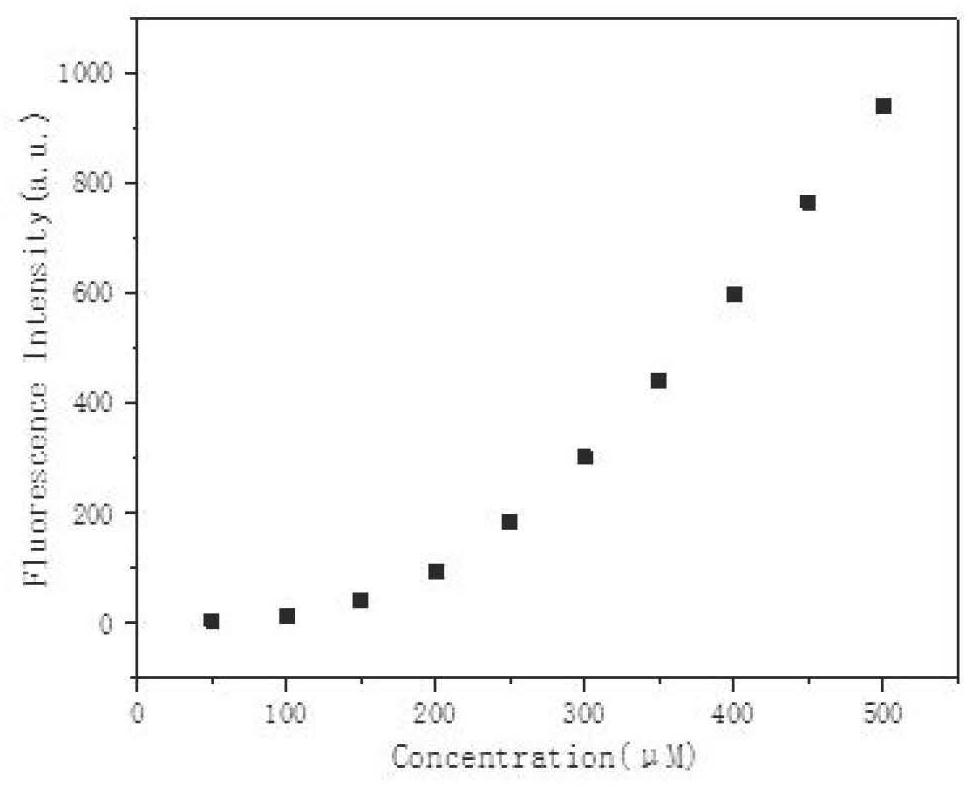A fluorescent probe for rapid detection of hydrazine compounds and its synthesis and application
A hydrazine compound and fluorescent probe technology, applied in the field of fluorescent probes, can solve the problems of inability to realize real-time analysis and biological imaging, long detection time, complicated operation, etc., and achieve fast and efficient detection, low synthesis cost, and synthesis yield. high effect
- Summary
- Abstract
- Description
- Claims
- Application Information
AI Technical Summary
Problems solved by technology
Method used
Image
Examples
Embodiment 1
[0039] This embodiment provides a method for synthesizing fluorescent probes for rapid detection of hydrazine compounds, including preparing A-1 and A-2, and the specific steps are as follows:
[0040] The method for preparing 0.3 g of probe A-1 includes the following steps: accurately weigh 0.60 g (1.5 mmol) of dichlorofluorescein into a 100 ml round-bottomed flask, add 20 ml of dichloromethane under nitrogen protection, and stir to dissolve, then at 0° C. Add 0.20mL triethylamine (1.8mmol) and 0.25mL acryloyl chloride (3mmol) successively under ice bath, mix and stir for 10min, and react at room temperature for 12h. During this period, a small amount of substances are identified and qualitatively analyzed by TLC, and the reaction process is followed. After the reaction is completed, vacuum Remove the solvent, elute with a 6:1 volume ratio of petroleum ether-ethyl acetate eluent with a gradient of 25%-65% / 60min, the flow rate during elution is 6mL / min, and obtain the probe aft...
Embodiment 2
[0044] This example provides an application of a fluorescent probe for rapid detection of hydrazine compounds, illustrating that the fluorescent probe synthesized in Example 1 can detect hydrazine compounds with naked eyes.
[0045]Add 10 μL of hydrazine compound (500 μM, 50eq) to the buffer solution containing fluorescent probe, the buffer solution is PBS and DMSO solution with a volume ratio of 9:1, the concentration is 10 μM, the pH is 7.4, after fully reacting for 1 h, under natural light, Compared with the blank solution, the solution system becomes obvious yellow-green after the reaction between the fluorescent probe and the analyte; under the 325nm ultraviolet lamp, it is found that the hydrazine compound exhibits obvious yellow-green fluorescence, which shows that the fluorescence synthesized in Example 1 The probe can realize naked eye detection of hydrazine compounds.
Embodiment 3
[0047] like Figure 2-10 , this example provides an application of a fluorescent probe for rapid detection of hydrazine compounds, indicating that the fluorescence intensity of the fluorescent probe synthesized in Example 1 increases with the increase of the concentration of hydrazine compounds.
[0048] A-1: Add 0, 50, 100, 150, 200, 250, 300, 350, 400, 450, 500 μM of hydrazine, hydrazine sulfate, hydrazine nitrate, partial dihydrate to the buffer solution of probe A-1, respectively. For methylhydrazine, the fluorescence intensity changes at 523 nm were detected, respectively. The result is as Figure 3-6 As shown, the fluorescence intensity of probe A-1 increases significantly with the increase of the concentration of the analyte. The calculated detection limits of probe A-1 for hydrazine, hydrazine sulfate, hydrazine nitrate and unsymmetrical dimethylhydrazine are: 0.21 μM, respectively. (6.7 ppb), 0.24 μM (31.2 ppb), 0.21 μM (19.9 ppb) and 0.64 μM (38.5 ppb).
[0049] A...
PUM
 Login to View More
Login to View More Abstract
Description
Claims
Application Information
 Login to View More
Login to View More - R&D
- Intellectual Property
- Life Sciences
- Materials
- Tech Scout
- Unparalleled Data Quality
- Higher Quality Content
- 60% Fewer Hallucinations
Browse by: Latest US Patents, China's latest patents, Technical Efficacy Thesaurus, Application Domain, Technology Topic, Popular Technical Reports.
© 2025 PatSnap. All rights reserved.Legal|Privacy policy|Modern Slavery Act Transparency Statement|Sitemap|About US| Contact US: help@patsnap.com



